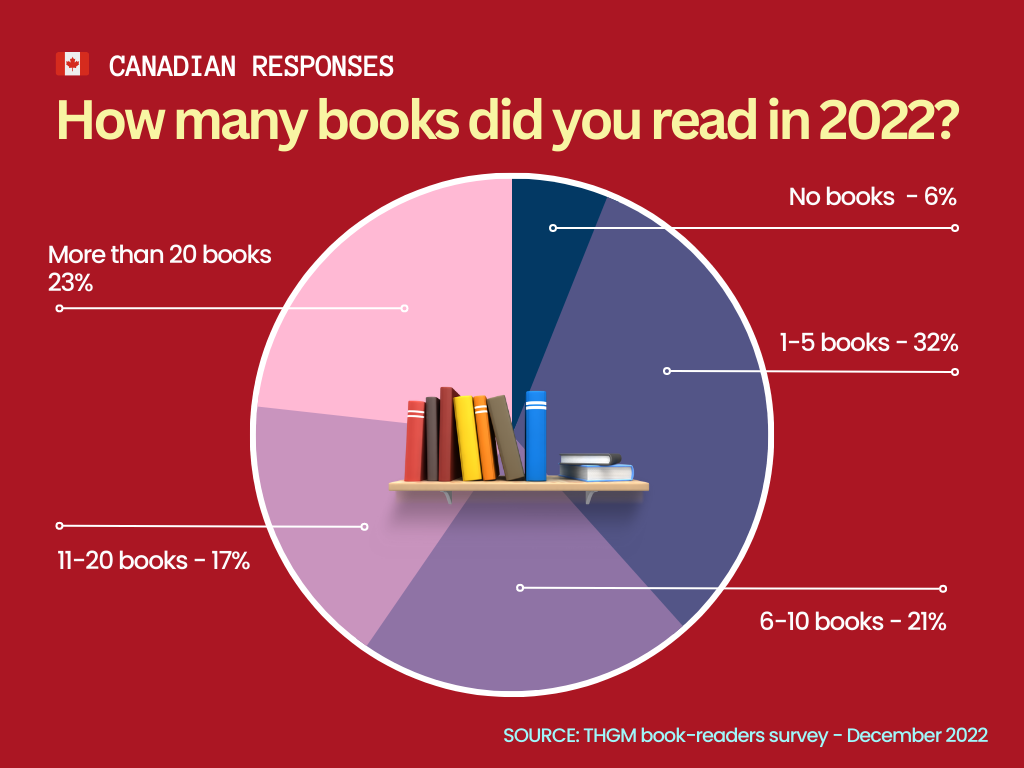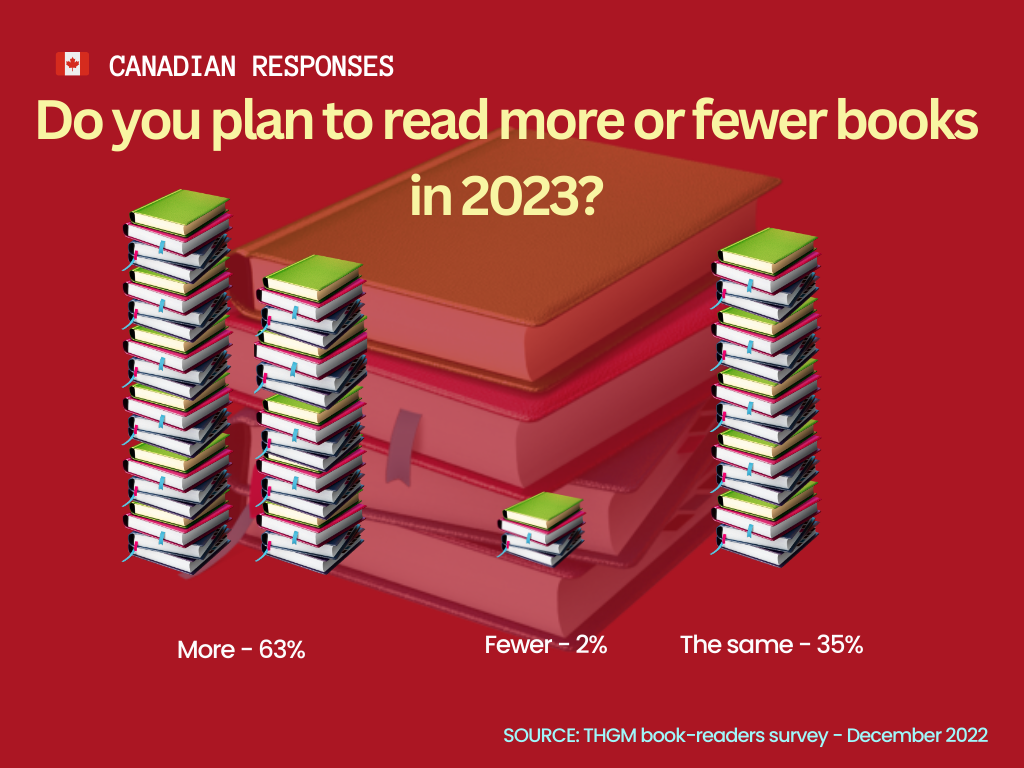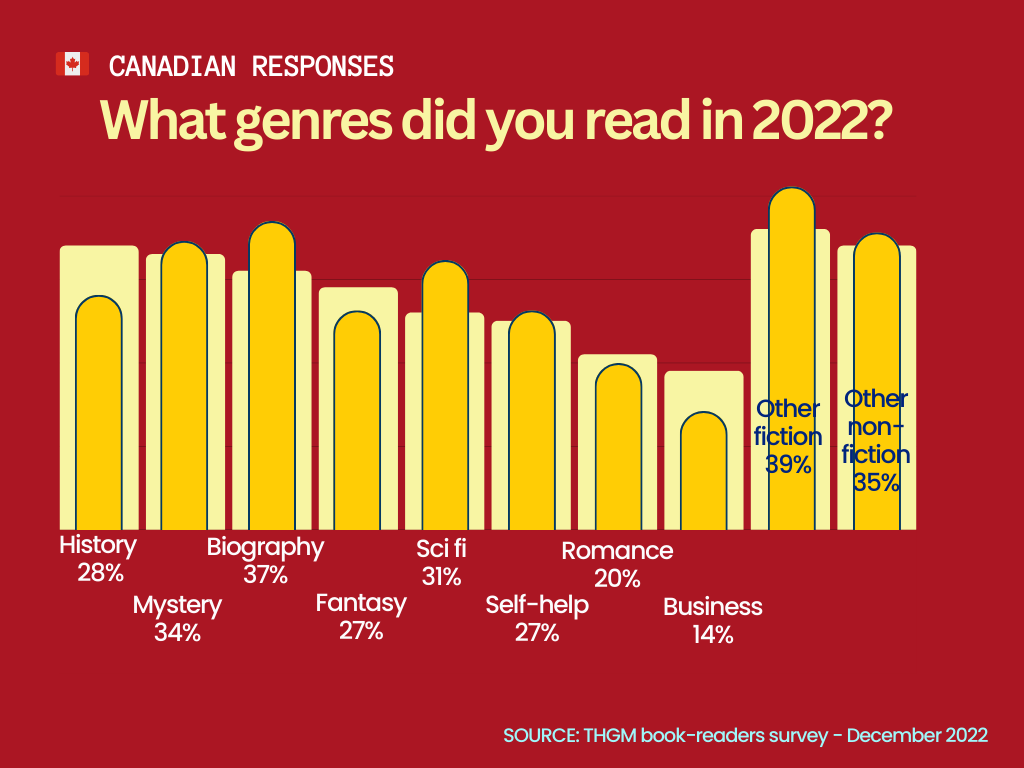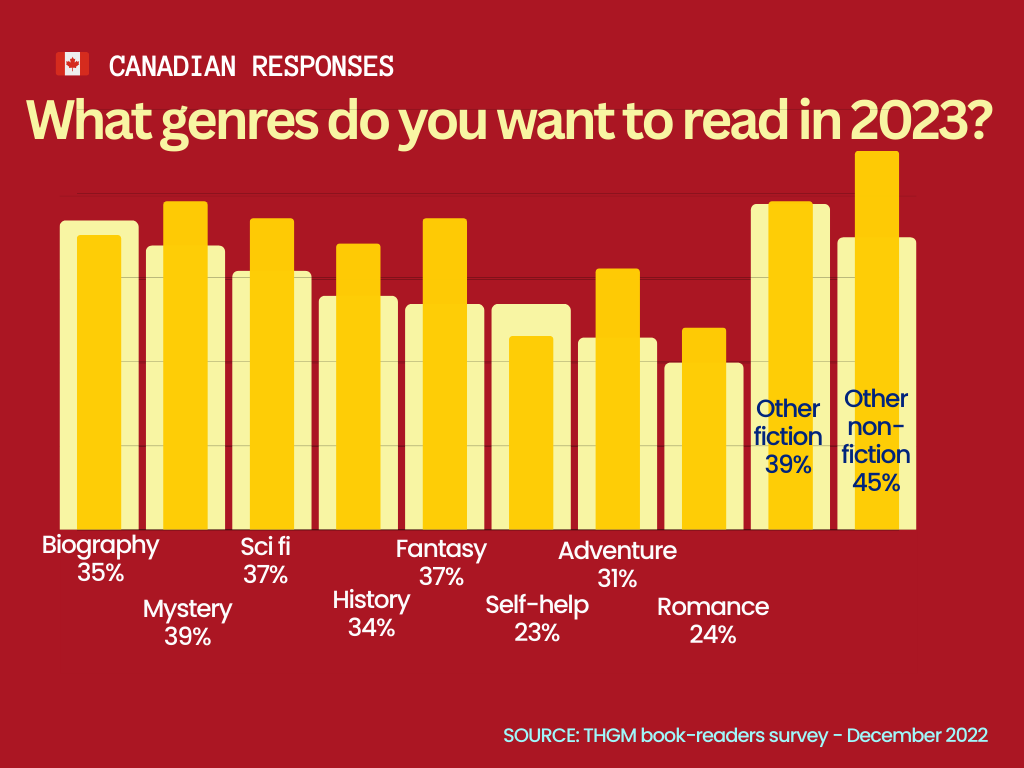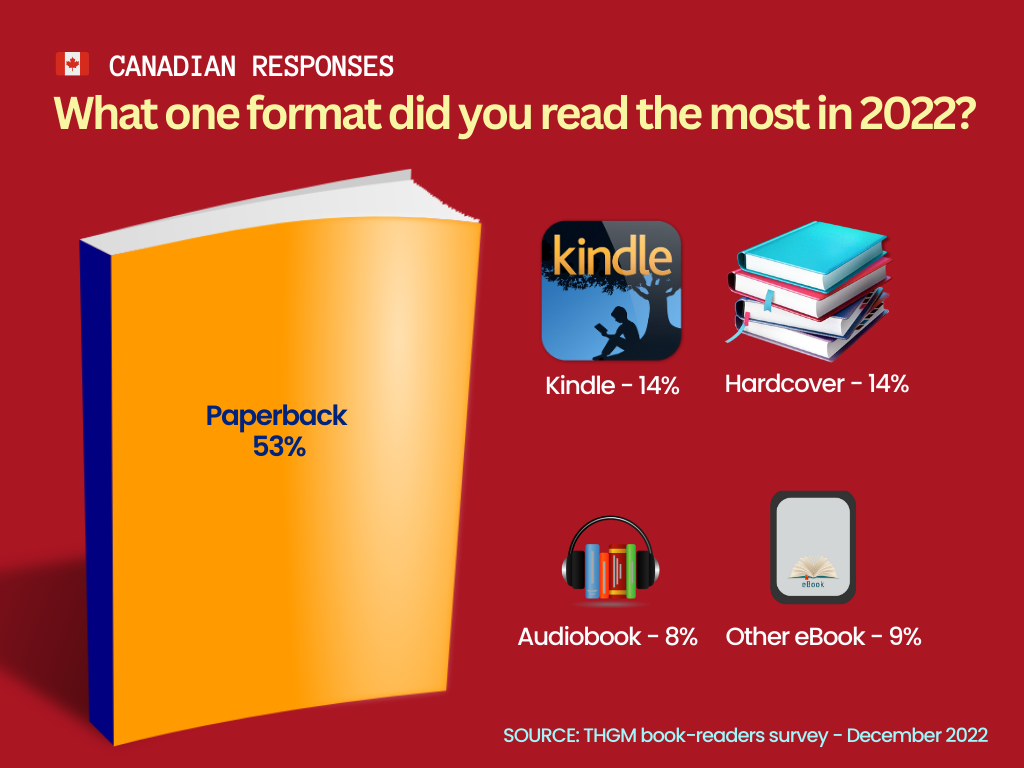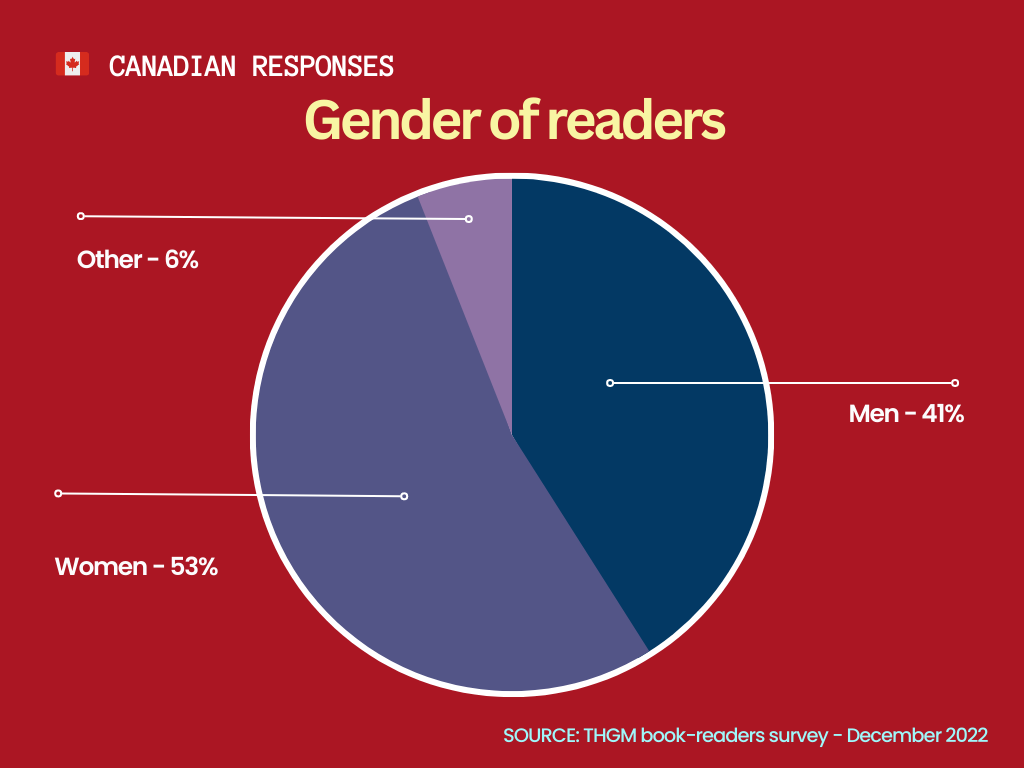What are the most popular books in Canada? We asked 144 Canadian readers what genre of books they read in 2022 and what they plan to read in 2023. Here are the Canadian book reading statistics from the survey results.
We wanted to know what, how and how much people were reading. So, we asked 945 readers in 56 countries about their book reading habits. This is what the 144 Canadian participants told us.
- Click here for the global book reading data from all 56 countries.
- Click here for the book reading data from just the United States.
Reading is alive and well. People around the world responded to our book reading survey, and they shared the details of the books they read and how they read them. Here are some of the key findings of the Canadian participants.
Key findings from the book reading statistics
- Key finding 1: Canadian readers are very varied in how much they read.
- Key finding 2: Canadian readers plan to read more in 2023, particularly non-fiction.
- Key finding 3: Canadian readers are less interested in history than others are.
- Key finding 4: Canadian readers still love paper, even more than the rest of the world.
- Key finding 5: Canadians like the length of their books even more than people elsewhere.
- Key finding 6: Readers come in all ages.
- Key finding 7: More women see themselves as readers than men.
We captured the data. We captured the uncensored, anonymous comments. Here’s what we found about Canadian book reading habits.
Key finding 1: Canadian are very varied in how much they read.
We asked Canadians how many books they read in 2022. It turns out there are many light readers, and quite a few love their books, but much fewer moderately-committed readers.
Survey says: 23% said they read over 20 books in 2022. This is much higher than the world average of 27%. 32% said they read one to five books. Just 21% said they read six to 10 books, and 17% read 11 to 20 books in 2022.
These book reading statistics are similar to the global data, but with somewhat fewer in the high range and somewhat more in the lower range. Canadians appear to be a bit lighter readers than people in other countries. Nevertheless, other research shows that one in three Canadians read daily, which is cause for hope.
Key finding 2: Canadian readers plan to read more in 2023, particularly non-fiction.
Predictions that the days of books were over have not (yet) come to pass. People, including Canadians, plan to read even more in 2023 than they did in 2022.
Survey says: 63% of readers in Canada plan to read more books in 2023 than they did in 2022. Just 2% plan to read fewer books. These statistics are similar to the world data.
Whether people end up reading more in 2023, or simply aspire to do so, remains to be seen. However, the intention to read more shows that Canadians still love their books.
Key finding 3: Canadian readers are less interested in history than others are.
We asked Canadians about the books they are reading. We wanted to know if they were reading fiction or non-fiction more. And we wanted to know what genres they preferred.
Survey says: the three top genres in Canada in 2022 were:
- Biography/memoir 37% of Canadian readers (above the global average of 31%)
- Mystery 34% of Canadian readers (about the global average of 33%)
- Science fiction: 31% of Canadian readers (above the global average of 26%)
Most notable is that the world’s most popular genre, history, came in fourth place in Canada with just 28% compared to the global average of 34%. Right behind history were fantasy and self-help, each with 27%.
You can see in the bar chart below how different reading habits are in Canada than the rest of the world. The numbers and the dark yellow pillars represent Canadian data, superimposed on the global statistics as pale yellow bars.
Canadians said they plan to read more in 2023, so it’s no surprise that they plan to read more of most genres in 2023 – even history. But it is fiction they most want to read more of,
Survey says: the three top genres people across Canada plan to read in 2023 are:
- Mystery (39%)
- Science fiction (37%)
- Fantasy (37%)
History actually falls to fifth place, as other genres in demand were biography, history and adventure. Both other fiction and other non-fiction were selected by even more readers (39% and 45% respectively).
In the graph below, the numbers and the deep yellow bars represent what Canadians plan to read in 2023. They are superimposed over the pale yellow bars, which represent what they read in 2022. You can see that in almost every genre, Canadians want to read the same or more in 2023.
Key finding 4: Canadian readers still love paper books, even more than the rest of the world.
In the age of the paperless office, does anybody still read paper, or am I the only one?
If this survey served any purpose, it is to affirm that I am not alone. I wrote about the pros and cons of eBooks in 2017, citing more pros than cons. Yet, I still read paper, and so do many readers, especially Canadians, according to the latest book reading statistics. We asked people to name the one format they read the most in 2022.
Survey says: 67% of Canadian readers read paper (print books) most – 53% paperback and 14% hard cover. That is 10% higher than the global average. 23% of Canadian readers chose eBooks – 14% Kindle and 9% other eBooks. Another 8% listened to audiobooks. This is consistent with what other research says. In 2020, 60% of Canadians read a print book, while 25% read an eBook.
Key finding 5: Canadians like the length of their books even more than people elsewhere.
Writers sometimes struggle with their manuscripts. Is my manuscript too long? Should I tighten it up? Will people find my book too short or too long?
Writers: keep doing what you’ve been doing.
Survey says: according to the latest book reading statistics, 90% of Canadian readers and 86% of readers around the world think their books are just the right length. 10% of Canadians think they are too long in this age of short attention spans, but 2% of dedicated bookworms think their books are too short.
Key finding 6: Readers come in all ages.
If you thought that the enduring popularity of books, and paper books in particular, was due to old-timers having difficulty adapting to new technology, this survey suggests otherwise.
Survey says: Canadian readers are fairly well spread out across the age ranges of 18-24, 25-34, 35-44, 45-54, 55-64 and 65+, according to the latest book reading statistics.
Key finding 7: More women see themselves as readers than men.
You might wonder: who reads more, women or men?
Survey says: 53% of respondents in Canada were women, 41% were men and 6% identified as other. Globally, 56% of respondents were women, and 42% were men. This is consistent with other research that shows girls and women read more books.
Survey methodology and limitations
We surveyed 144 Canadians in December 2022 to gather book reading data. Because this is an Internet poll, no margin of error is assigned to the results. The results have not been weighted by age, gender, location or any other factor.
This was not a random survey. Respondents tended to self-identify as “readers”. People who do not read books or have not read books in a while declined to participate. When citing this survey, it would be most accurate to refer to “Canadian readers”.
The survey was disseminated primarily through social media. The accounts used to reach people were primarily on Twitter and LinkedIn, as well as on Facebook and some smaller networks. The bias on these accounts, based on the composition of their followers, skews towards:
- writers, authors and self-identified book lovers
- bloggers and online marketers
- other artists (musicians, crafters, photographers, etc.)
The bias on these accounts, based on the composition of their followers, skews away from:
- sports-themed accounts
- religion-focused themes
- scientists and healthcare accounts
- fashion-focused accounts
- food- and travel-themed accounts
A HUGE “Thank you!” to all Canadians who completed the 2022-2023 book reading survey and shared their reading habits with us. You people rock!
Permission is granted to republish the graphics on this page and cite the book reading statistics. Attribution is required, and a link back would be appreciated (and useful for readers) but not required.



